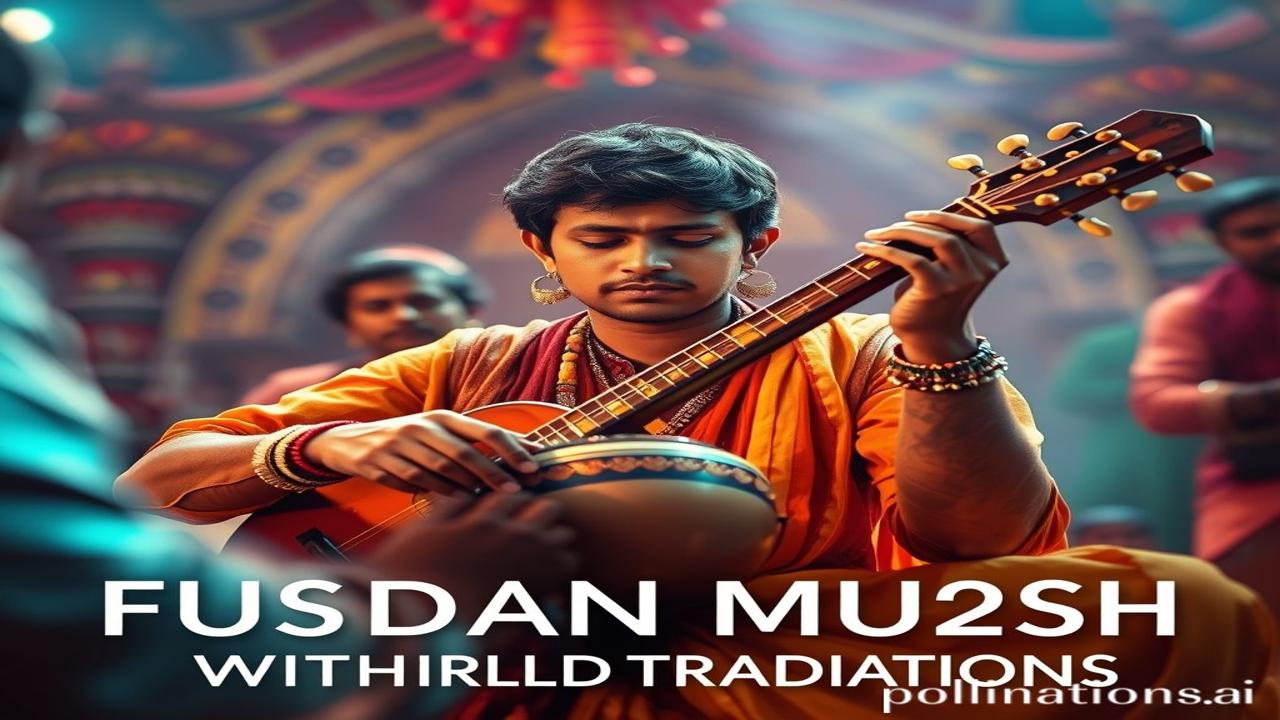Bharat Ki Dhun, Duniya Ke Rang: The Enchanting Fusion of Indian Music
Kabhi socha hai, agar Raag Yaman ne Paris ki sarko pe dance kiya, toh kaisa lagega? Ya tabla ne Latin rhythms ke saath jugalbandi ki? Humari sangeet parampara, Bharat ki aatma, duniya ke saath milkar ek naya roop le rahi hai. Yeh sirf music nahi hai; yeh hai ek kahani, ek milan, ek naya Bharat jo apni jadon se juda rehkar bhi aasmaan ko chhoona chahta hai.
Indian Music: A Timeless Tapestry
What is Indian music, really? It’s more than just notes and melodies. It’s a tapestry woven from thousands of years of history, spirituality, and emotion. Imagine the chants of the Vedic priests, the soulful songs of the Sufi saints, the intricate rhythms of the tabla, the piercing beauty of the sitar – all blending together to create a soundscape unlike any other in the world.
This rich heritage, passed down through generations of gurus and shishyas, has always been open to interpretation and innovation. From the ancient courts of the Mauryas to the bustling bazaars of Mughal India, music has been a vital part of our culture, evolving and adapting to the changing times.
A Journey Through Time: Seeds of Fusion
The seeds of fusion were sown long ago. Remember the arrival of the Mughals? They brought with them Persian influences, which subtly intertwined with existing Indian styles, giving rise to new forms like khayal and thumri. Then, with the arrival of the British, Western harmonies and instruments began to make their presence felt. Think of the early orchestras playing Indian tunes with a Western flair!
But the real explosion of fusion happened in the 20th century. Figures like Pandit Ravi Shankar, Ali Akbar Khan, and Yehudi Menuhin dared to break boundaries, collaborating with Western musicians and introducing Indian music to a global audience. Ravi Shankar’s performance at Woodstock in 1969 was a watershed moment, catapulting Indian music onto the world stage.
Life in the Raag: Echoes of the Past
Imagine a small village in Rajasthan, where a group of Manganiyar musicians are preparing for a performance. The air is thick with the aroma of spices and the sounds of instruments being tuned. The old sarangi player, his face etched with the wisdom of generations, tells his grandson, “Beta, sangeet toh aatma ki awaaz hai. Ismein dhun toh apni, par rang duniya ka bhi daal sakte ho.”
Ma Rukmini, decked in vibrant colours, starts to sing a devotional song, her voice soaring above the desert landscape. The rhythm of the dholak echoes through the village, drawing everyone in. They are not just performing; they are living the music, breathing the tradition, and adding their own unique flavour to the ancient melodies.
Indian Music Today: A Global Symphony
Today, the fusion of Indian music with world traditions is everywhere. From Bollywood soundtracks that blend Indian classical elements with Western pop and electronic beats, to independent artists experimenting with everything from jazz to hip-hop, the possibilities are endless. Think of artists like Anoushka Shankar pushing the boundaries of sitar playing, or Zakir Hussain collaborating with jazz musicians, creating a sound that is both deeply rooted in tradition and boldly innovative.
This fusion is not just about mixing sounds; it’s about building bridges between cultures. It’s about sharing our dharohar (heritage) with the world and embracing the richness and diversity of global musical traditions. It’s Bharatiyata (Indianness) expressed in a universal language.
Fun Fact: Beyond the Sitar!
Log samajhte hain ki Indian music ka matlab sirf sitar hai. Lekin asli sach yeh hai ki humare paas dher saare anmol instruments hain jaise ki sarangi, santoor, rudra veena, shehnai. Har instrument ki apni ek alag kahani hai aur yeh sab milkar Indian music ko ek unique sound dete hain.
Sensory Overload: The Smell of Music
Close your eyes and imagine yourself at a concert featuring Indian classical music infused with jazz. The air is thick with the scent of incense and the faint aroma of jasmine garlands. The stage is bathed in warm light, and the walls resonate with the vibrations of the instruments. The sound of the sitar blends seamlessly with the saxophone, creating a mesmerizing soundscape that transports you to another world. The feeling is one of pure joy and spiritual awakening.
An Ode to Harmony
“सत्यं शिवं सुन्दरम्” – Satyam Shivam Sundaram. This timeless Sanskrit phrase encapsulates the essence of Indian art and culture. It speaks to the pursuit of truth, beauty, and goodness – values that are beautifully reflected in the ongoing fusion of Indian music with world traditions. Let us continue to celebrate this harmonious blend, for in it lies the promise of a richer, more interconnected world.
